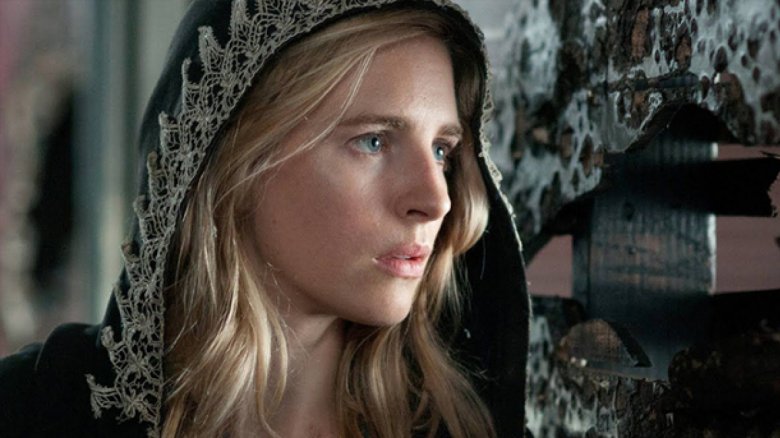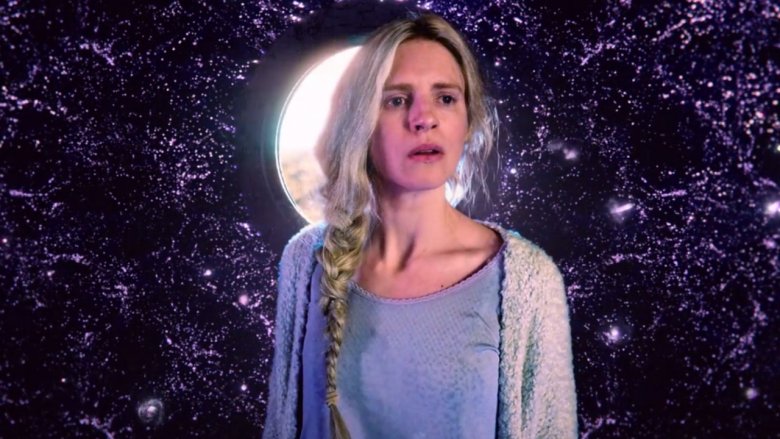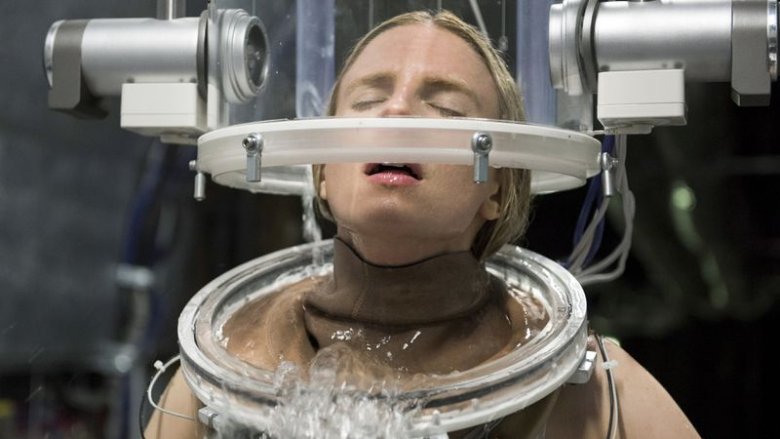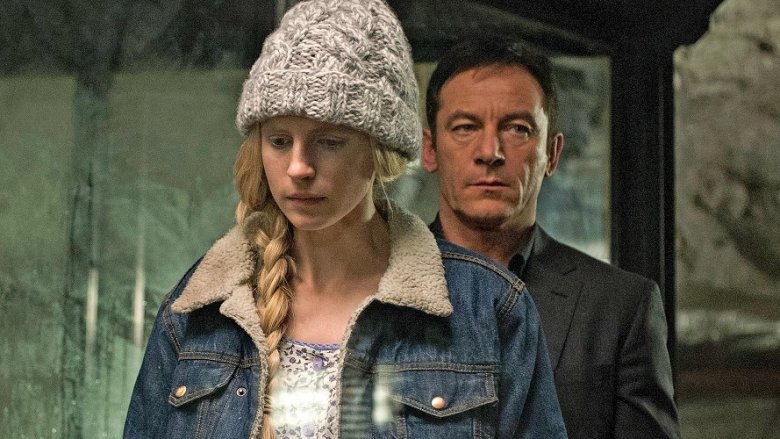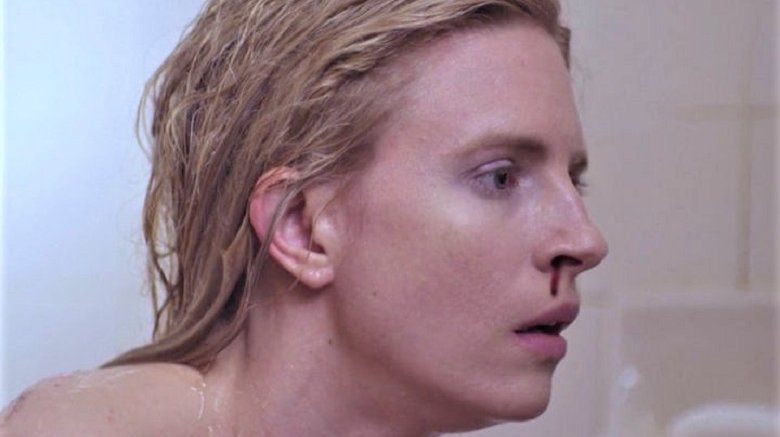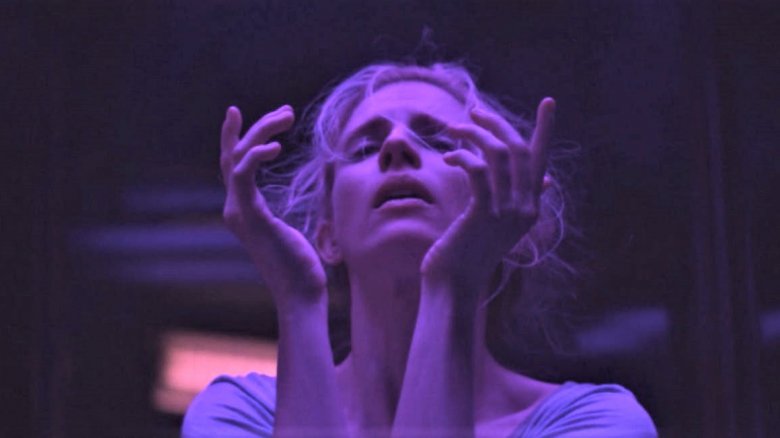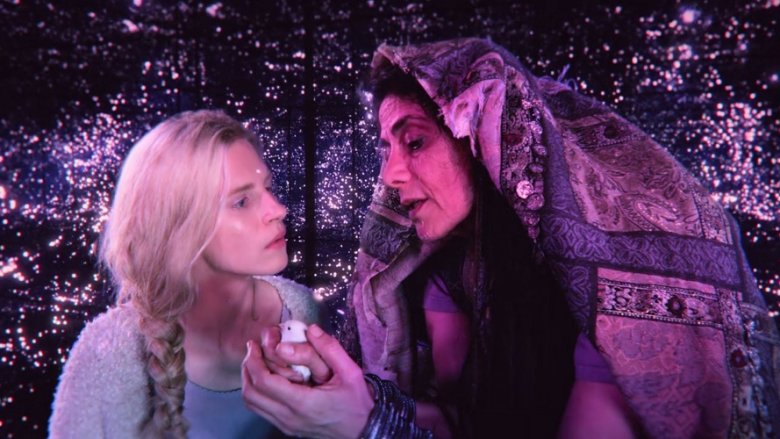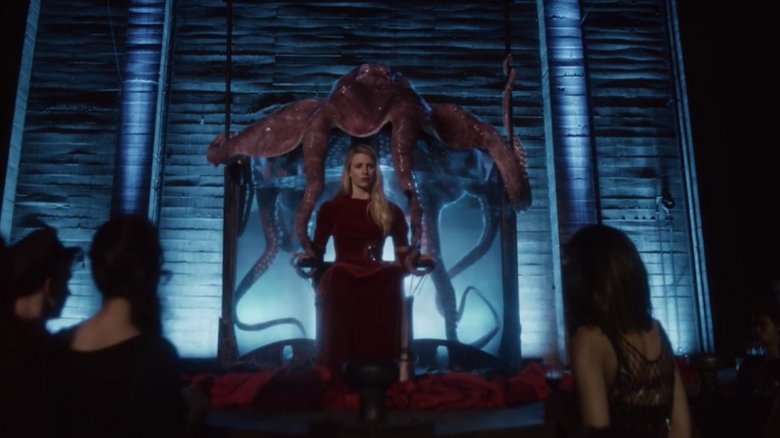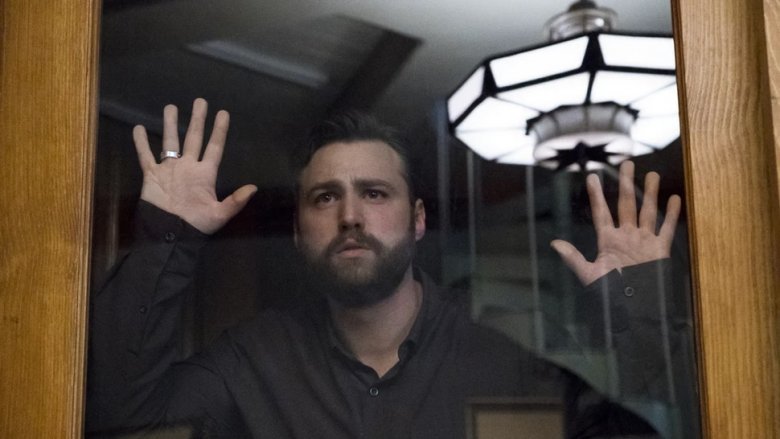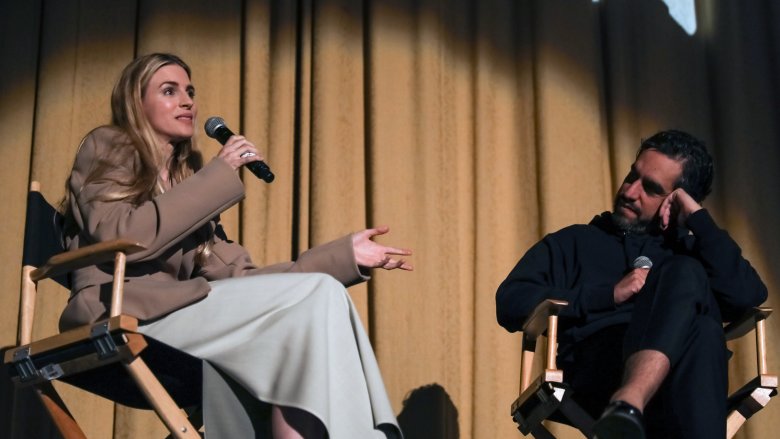The Real Reason Netflix Canceled The OA
The OA appeared on Netflix in 2016 with little fanfare, made available to stream on the platform just days after it was announced. In 2019, the show was killed off just as abruptly, canceled two seasons into what was supposed to be a five-season arc. Brit Marling, who starred as a missing blind woman that reappears seven years after her disappearance with her sight miraculously restored, took to Instagram to thank fans of the show after hearing the news. "Zal [Batmanglij, Marling's co-creator] and I are deeply sad not to finish this story," she said. "The first time I heard the news I had a good cry. [...] It's been an intense journey for everyone who's worked on and cared about this story."
Those people who cared about the story have been reacting angrily to The OA's axing, pointing out that both seasons of the show were positively received by the majority of critics. A petition to save The OA is gaining momentum, but history has taught us that once a show finds itself in the Netflix graveyard, chances are it's there to stay. The decision has been made, but why exactly did execs decide to pull the plug on this mind-bending mystery thriller? Here's why The OA was canceled.
High production costs could have doomed The OA
Netflix doesn't release its viewing figures, so it's impossible to say whether the amount of people streaming The OA impacted the decision to axe it. What we do know is that the streamer makes these decisions based on a simple ratio: viewership versus cost. Netflix has confirmed that it adheres to this formula, and according to TheWrap, an insider with "knowledge of Netflix's decision to cancel the drama" two seasons in has confirmed that The OA fell on the wrong side of the equation. The OA was "a big creative swing" for the company, the source said, and while it was one that Netflix was "proud to take" it just wasn't paying off.
In June 2019, Netflix chief content officer Ted Sarandos reportedly ordered dozens of his TV and movie execs to rein in their spending. People familiar with the high-level meeting told The Information it was made clear that bigger budget projects needed to bring in the viewers going forward — building buzz and industry credibility was no longer enough. According to Michael Nathanson, an analyst with Wall Street research firm MoffettNathanson, Netflix has been "overspending relative to what they need" and this attitude is apparently being phased out. The OA is far from the only show Netflix has culled in 2019; Drew Barrymore-led horror comedy Santa Clarita Diet and the star-studded Friends from College are among the high-profile casualties.
The OA isn't the kind of show that attracts new subscribers
According to CNN, Netflix registered a record 9.6 million new subscribers in the first quarter of 2019, a 25 percent increase on the previous year. That brings the overall total to just shy of 150 million, though the company isn't content with those figures. Its business model relies not only on the retention of subscribers, but the steady influx of new ones, and shows like The OA don't help in that department. It was critically acclaimed, yes, but the Netflix metric deemed that it was no longer a draw.
"Netflix has learned that the first two seasons of a show are key to bringing in subscribers — but the third and later seasons don't do much to retain or win new subscribers," The Information claims. "Ending a show after the second season saves money, because showrunners who oversee production tend to negotiate a boost in pay after two years." Understandably, this approach isn't popular with producers, especially those running shows designed to be told over multiple seasons. Shows like The OA.
"It's really hard to get them to put money into a third season," the creator of a Netflix show that was axed after two seasons alleged. "For a creator, you want to be able to reward your audience with more seasons." She's Gotta Have It, American Vandal and Friends From College (all canceled in 2019) only got to two seasons. Netflix has denied that this is a new policy.
The OA wasn't binge-worthy enough
On the surface, The OA is your typical binge-worthy Netflix show, teasing viewers with glimpses of what's to come in order to keep them rooted in their seats for hours on end. That relationship between show and viewer only functions if the build up to those glimpses is satisfying enough in its own right, however, and in the case of The OA, it was very much a one-sided relationship. "Backloaded twists are the perfect incentive to click 'next' to continue a binge," The Ringer said. "But Marling and Batmanglij forgot to deliver much of anything before the twist."
Put simply, The OA requires viewers to sit through hours of speculative twists and turns for very little in return. Questions are answered with questions that lead to yet more questions, and that's only one of the two vital components of binge TV. This approach (described as "maddeningly vague" by Variety) probably led to numerous viewers ditching the show halfway through, because, as The Observer put it, "like Kevin Hart or crack cocaine The OA is best consumed in small doses." While traditional TV networks may be willing to churn out endless episodes of a show based on mystery alone (think ABC's Lost), Netflix isn't going to continue to fund a show that loses people's interest before they get to the payoff.
The OA is a poor man's Stranger Things
While Netflix keeps a tight lid on its viewing figures, it made an exception for Stranger Things. Days after the third season of the Spielbergian sci-fi show dropped, the streaming giant boasted about how it had been "breaking Netflix records" in a tweet. "40.7 million household accounts have been watching the show since its July 4 global launch — more than any other film or series in its first four days," the company revealed. Stranger Things and The OA were actually greenlit around the same time, but Stranger Things got out of the gate first. Creators the Duffer brothers and The OA's Zal Batmanglij used to meet up in those early days, and you can't help but feel as though they borrowed from each other.
Not only does Brit Marling's Prairie Johnson enlist the help of four high school students when she returns to her Midwestern town after being experimented on, she even has Eleven-style nosebleeds after her premonitions. At one stage Jesse (Brendan Meyer) and his sister actually watch an episode of (you guessed it) Stranger Things, described as an "aggravating bit of cross-promotion" by the AV Club. "Netflix was very much trying to draw a link between the two shows — likely because they have similar elements — but that shout-out was just too obvious." The company clearly wanted Stranger Things and The OA to co-exist, but one ended up being a poor man's version of the other and was ultimately deemed surplus to requirements.
Is The OA too pretentious for its own good?
The word "pretentious" popped up time and time again in reviews of The OA. Co-creators Brit Marling and Zal Batmanglij come from the indie world, where quirkiness is sometimes celebrated over narrative structure. This approach doesn't always translate well to television, and The OA is living proof. The Hollywood Reporter's Daniel Fienberg called Marling and Batmanglij's Netflix show a "failed, but not wholly worthless, experiment in TV auteurism," and this was being kind — while the majority of TV critics agreed that the show did have its merits, many of the industry's most respected reviewers saw too much style and not enough substance.
Variety's Sonia Saraiya wrote the show off as "self-indulgent, self-serious psychodrama" in her review, while Vinnie Mancuso (writing for The Observer) compared it to another axed Netflix series. "[The OA] plays like a somehow more pretentious Sense8, if the Wachowskis had decided 'No, give the audience less information,'" he said. The problem only seemed to intensify in the show's second, and final season. According to IndieWire's Ben Travers, The OA Part II "doubles down in a longer, more pretentious, and less vigorous follow-up season that's part puzzle box, part romance, and wholly insane."
The OA was unintentionally funny
A show that takes itself too seriously can sometimes come across as funny, and that's a criticism that's been thrown at The OA in numerous reviews. "I cannot stop laughing at The OA," Vinnie Mancuso said in his writeup for The Observer, while Vox critic summed the utterly bizarre nature of Marling and Batmanglij's series up perfectly when she said that it "feels like the sort of show that would be a background joke in an episode of BoJack Horseman and/or something Jack Donaghy would pitch on 30 Rock." Unfortunately for the creators, these unintentional laughs continued in The OA Part II.
The Guardian's Jack Seale claimed that he "lost it and started bellowing with laughter when a choir of blind children in swimming costumes appeared in the bar of some Russian-American fetish theatre" in one particularly out-there season two scene, and he wasn't the only one reduced to the wrong kind of tears. "You'll cry from laughing or simply stare blankly at the screen," IndieWire's Ben Travers said, "and you're asked to take it all very, very seriously." If The OA leaned into the wackiness a little more like, say, Doctor Who, it might get away with it. But it doesn't, and that's been a big part of its downfall.
The OA jumped the octopus
If there's one single moment in season two of The OA that seemed to push people over the edge, it's when Marling meets a telepathic octopus in the fourth episode. Yes, a telepathic octopus. We had already been through a whole lot of craziness by the time the show's protagonist encounters Old Night (real name Azrael, the Angel of Death in various religious texts). This extraordinary octopus communicates with revellers at a packed nightclub via our dimension-traversing hero, and it was simply too much for some viewers. Even ardent fans of the show were left utterly perplexed by what they had witnessed, and (in true The OA fashion) answers weren't exactly forthcoming.
"The second season almost seems like it wants to invent new terms that will render old ones like 'jumping the shark' and 'nuking the fridge' quaint and obsolete," IndieWire's Joshua Meyer said. "The octopus scene was the tipping point where I went from being patient with the show and intermittently enjoying it to resenting it." Meyer's opinion was echoed by his fellow critic Jack Seale, who called the octopus scene the "final straw" in his review for The Guardian. Netflix has employed what The Ringer described as a "famously hands-off creative policy" in years gone by, but this might have been too much even for them.
The OA caters exclusively to its cult audience
One of the biggest issues with The OA is that it seemed to be catering almost exclusively to a cult audience. The show built up a dedicated following after its first season, and rather than trying to expand that following by making season two a little more accessible to new viewers, Marling and Batmanglij seemed to lean even further into the weirdness. The result was a second season that isolated anyone that didn't have the patience for telepathic octopuses and dancing robots, and isolating potential customers isn't part of the Netflix business model.
Could the fact that The OA pandered to its fandom a little too much have been a factor in Netflix pulling the plug? According to Slashfilm's Joshua Meyer, the show seemed to take pleasure in the fact that it created an exclusive club for people who were willing to go along with whatever it threw at them. "It gathers fans around itself in a candlelit attic and seeks to regale them with a tall tale," Meyer said in his review The OA Part II. "The show has big ideas, but its characters are all too quick to chase magic mirrors on blind faith. If you're invested in those characters, then you might be willing to drink from the same pitcher of Kool-Aid that they do."
The OA was about to get super meta
Season two of The OA ended in the same way that the first one did — Marling jumps into a brand new dimension, resetting the deck for a third season that was never to be. What does this have to do with Netflix pulling the show? It's not the fact that she leaps into another reality (that was, after all, to be expected after the opening season ended in a similar fashion), it was the reality that she leapt into. Prairie ends up in our world. She's an actor on a set, presumably shooting The OA. Confused? That's kind of the idea. Netflix isn't easily put off by high concepts, but they'd already pulled this particular trick with Black Mirror: Bandersnatch.
Released just three months before The OA's second season, this interactive film presented viewers with regular choices, allowing them to take protagonist Stefan Butler (Fionn Whitehead) on a journey of their choosing. One of the most talked-about endings involves Stefan finding out that he's part of an interactive Netflix movie. After attempting to explain this to his psychiatrist he tries to flee, but the camera pulls back to reveal a set and the director walks into the frame. It was a fun scene, but it was exactly that — a scene. It appeared as though The OA was going to try and stretch this concept out for an entire season, something that Netflix apparently wasn't interested in.
Are the creators of The OA secretly working on another Netflix project?
Could co-creators of The OA Brit Marling and Zal Batmanglij already be working on another project for Netflix? Their first show might be done, but the language that Marling used when she took to Instagram following news of The OA's cancellation seemed to suggest that something else could be in the pipeline. "We feel profound gratitude to Netflix and the people we have worked with there for making it possible to make Part I and Part II," the actress and producer posted. "While we cannot finish this story, I can promise you we will tell others."
Those other stories could well be told via a different platform, but Netflix's statement on the matter also suggested that their relationship with Marling and Batmanglij wasn't over. "We are incredibly proud of the 16 mesmerizing chapters of The OA and are grateful to Brit and Zal for sharing their audacious vision," Cindy Holland, vice president of original content for Netflix, said (via Variety). "We look forward to working with them again in the future, in this and perhaps many other dimensions."
There's no denying that Marling is a capable talent with more to offer, and the "dark flair" that Batmanglij brought as director of The OA didn't go unnoticed. "What might he do with a script in which the protagonists are rounded humans who meaningfully interact with each other? [...] Maybe one day we'll have the answer," The Guardian said.
